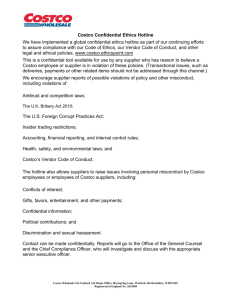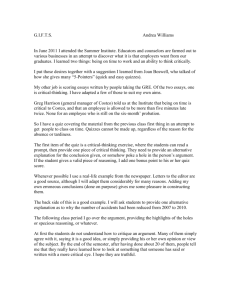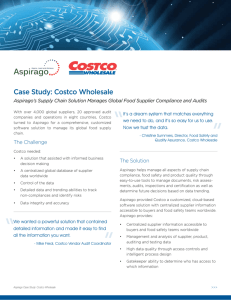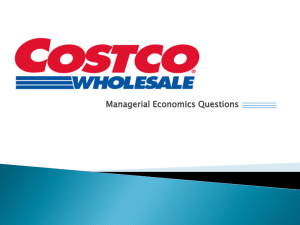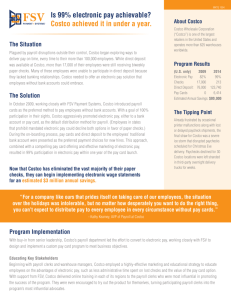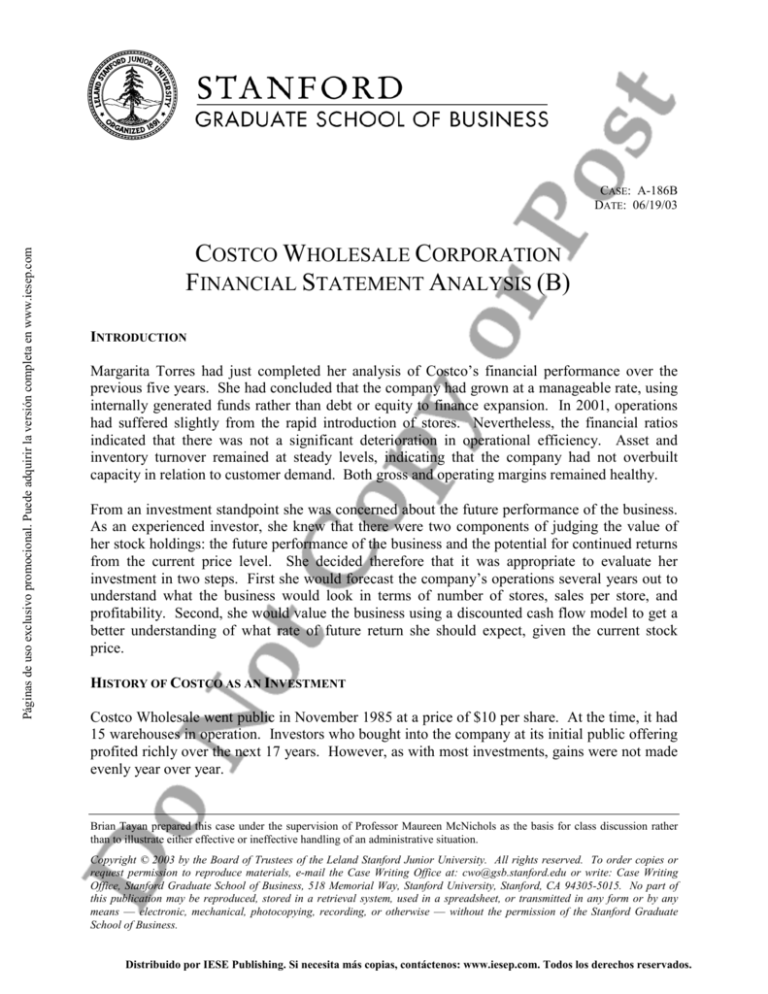
Páginas de uso exclusivo promocional. Puede adquirir la versión completa en www.iesep.com
CASE: A-186B
DATE: 06/19/03
COSTCO WHOLESALE CORPORATION
FINANCIAL STATEMENT ANALYSIS (B)
INTRODUCTION
Margarita Torres had just completed her analysis of Costco’s financial performance over the
previous five years. She had concluded that the company had grown at a manageable rate, using
internally generated funds rather than debt or equity to finance expansion. In 2001, operations
had suffered slightly from the rapid introduction of stores. Nevertheless, the financial ratios
indicated that there was not a significant deterioration in operational efficiency. Asset and
inventory turnover remained at steady levels, indicating that the company had not overbuilt
capacity in relation to customer demand. Both gross and operating margins remained healthy.
From an investment standpoint she was concerned about the future performance of the business.
As an experienced investor, she knew that there were two components of judging the value of
her stock holdings: the future performance of the business and the potential for continued returns
from the current price level. She decided therefore that it was appropriate to evaluate her
investment in two steps. First she would forecast the company’s operations several years out to
understand what the business would look in terms of number of stores, sales per store, and
profitability. Second, she would value the business using a discounted cash flow model to get a
better understanding of what rate of future return she should expect, given the current stock
price.
HISTORY OF COSTCO AS AN INVESTMENT
Costco Wholesale went public in November 1985 at a price of $10 per share. At the time, it had
15 warehouses in operation. Investors who bought into the company at its initial public offering
profited richly over the next 17 years. However, as with most investments, gains were not made
evenly year over year.
Brian Tayan prepared this case under the supervision of Professor Maureen McNichols as the basis for class discussion rather
than to illustrate either effective or ineffective handling of an administrative situation.
Copyright © 2003 by the Board of Trustees of the Leland Stanford Junior University. All rights reserved. To order copies or
request permission to reproduce materials, e-mail the Case Writing Office at: cwo@gsb.stanford.edu or write: Case Writing
Office, Stanford Graduate School of Business, 518 Memorial Way, Stanford University, Stanford, CA 94305-5015. No part of
this publication may be reproduced, stored in a retrieval system, used in a spreadsheet, or transmitted in any form or by any
means –– electronic, mechanical, photocopying, recording, or otherwise –– without the permission of the Stanford Graduate
School of Business.
Distribuido por IESE Publishing. Si necesita más copias, contáctenos: www.iesep.com. Todos los derechos reservados.
Costco Wholesale Corp.: Financial Statement Analysis (B) A-186B
p. 2
Páginas de uso exclusivo promocional. Puede adquirir la versión completa en www.iesep.com
The years 1985 to 1992 were a time of extreme appreciation in the stock price, well in excess of
the company’s operational success. During the years 1992 to 1995, the company’s stock price
corrected itself to be more in line with reasonable valuations, and investors who held it from
peak to trough saw a loss of 70 percent in their investment. This was also the time of the CostcoPrice Club merger, which caused short-term disruptions in operations. By the late 1990s, the
company regained steam operationally, and the price of the stock increased almost ten-fold by
May of 2000. By July 2002, the stock was off its all-time high, trading at around $35 per share.
Investors who put $1,000 in Costco stock at the time of its IPO saw their holdings grow to
$21,000 by July 2002, a compounded return of over 19 percent per year for almost 17 years. The
company’s stock traded on the NASDAQ under the symbol COST.
FORECAST
To determine a financial forecast for Costco, Torres went through the following four-step
process:
1. She listed the fundamental factors that would drive growth. Keeping in mind Albert
Einstein’s statement that “things should be made as simple as possible but not any simpler,”
she set an objective of isolating the four or five drivers that had the largest impact on
Costco’s future. She considered the constraints associated with each factor.
2. Second, she forecasted Costco’s income statement and computed a rough estimate of free
cash flow based on her determinations in step one.
3. Third, she ran a quantitative check on the numbers, comparing key ratios to the historical
results to consider the feasibility of her projections.
4. Fourth, she ran a qualitative check on the numbers to understand whether her projections
were conservative or aggressive.
In carrying out her analysis, she relied on diverse sources of information: industry reports such as
those compiled by Standard and Poor’s, research analyst reports, web casts with company
management archived on the investor relations section of company websites, and business
periodicals.
Growth Drivers
The first factor she considered was the number of warehouses that the company would operate in
the U.S. She had read in business periodicals that analysts thought the saturation point in the
U.S. market was 1500 warehouses shared among all competitors. Costco management, in its
third quarter 2002 conference call with analysts, said that it expected to operate between 500 and
600 stores in the U.S. by 20101. Management considered 500 conservative, 580 assertive, and
600 aggressive. With 289 U.S. warehouses in 2002, Costco had approximately a 30 percent
market share. Torres knew that there was intense competition among Costco, SAM’S, and BJ’s
1
Forward-looking comments made by management, here and throughout the case, taken from: Costco Wholesale
Corporation, “Audio Events: Q3 2002 Costco Wholesale Corporation Earnings Conference Call,” May 30, 2002,
http://www.costco.com (31 July 2002).
Distribuido por IESE Publishing. Si necesita más copias, contáctenos: www.iesep.com. Todos los derechos reservados.
Costco Wholesale Corp.: Financial Statement Analysis (B) A-186B
p. 3
Páginas de uso exclusivo promocional. Puede adquirir la versión completa en www.iesep.com
to expand in the U.S. SAM’S had announced plans to aggressively increase its own new store
openings.
The second factor she considered was sales per store. In more established warehouses, Costco
had U.S. sales per store of approximately $100 million, compared to $60 million for SAM’S, and
$45 million for BJ’s. All three companies felt that fresh food, luxury items such as fine wines
and jewelry, and ancillary products helped to increase same-store sales over time. Costco
management had stated that they would like to get U.S. store sales up to $125 million or even
$150 million per store. Was that possible? Also, with the companies increasingly entering each
other’s markets, what pressure would be placed on Costco’s store sales? Which company, if any,
would come out dominant?
The third important growth driver was the membership base. Costco located warehouses in areas
with a population of around 500,000 in a 15-mile radius. They expected to sign up
approximately 10 percent of those people as members. Torres was not sure whether membership
per store would increase or decrease, especially given the effects of competition. She did feel,
however, that Costco could raise the membership fee over time. The basic annual membership
fee was $25 in the mid-1980s. By now it was $45. Costco also had an executive membership,
which was $100. She felt that as customers spent more money on sales merchandise, the more
valuable they would perceive the membership to be and the more, in turn, Costco could charge.
Costco management reported that recent increases in the membership fee did not materially
change membership renewal rates, which average 86 percent.
The fourth important factor to consider was operating margins. Costco management had recently
stated that they felt they deserved to make more money from their business, given the value they
delivered to customers. Management noted that pretax margin had peaked at 3.3 percent in 2000
and fell to 2.9 percent in 2001. Costco wanted to increase their pretax margin to 3.4 percent to
3.6 percent over the next five years (Wal-Mart’s pretax margin was almost 6 percent). Torres
did not know how much of this increase would come from improved gross margin, resulting
from a change in pricing strategy, and how much from improved operating margins, where
operations were already very efficient.
The fifth main factor she considered was international expansion. Management had already
stated that its emphasis was on U.S. growth, but that it would grow internationally where it felt it
could do so profitably. Plans were to open four to eight warehouses per year internationally over
the next five years, and 10 to 15 per year over the subsequent five years.
Forecast Financial Statements
The next step was to forecast the financial statements based on her assumptions about the five
main growth drivers, using 2010 as a terminal year. She built the model in the following steps:
Merchandise Sales
1. Assumption: number of U.S. stores
2. Assumption: number of international stores
3. Assumption: sales per store
4. Output: merchandise sales
Distribuido por IESE Publishing. Si necesita más copias, contáctenos: www.iesep.com. Todos los derechos reservados.
Costco Wholesale Corp.: Financial Statement Analysis (B) A-186B
p. 4
Because the 20 stores Costco operated in Mexico were accounted for using the equity method
(based on 50 percent ownership), she kept track of them separately. Pro rata share of earnings
from the Mexican stores were disclosed on Costco’s income statement under “interest income
and other”; capital invested in these stores was listed on the balance sheet under “other assets.”
Páginas de uso exclusivo promocional. Puede adquirir la versión completa en www.iesep.com
Membership Revenue
1. Assumption: members per store
2. Assumption: revenue booked per member
3. Output: membership revenue
Operating Ratios
1. Assumption: cost of goods sold as a percent of merchandise sales
2. Assumption: SG&A as a percent of merchandise sales
3. Assumption: pre-opening expense per store
4. Assumption: interest expense
5. Output: income statement line items
After projecting the income statement for Costco, she projected year-end balance sheet amounts
in the following simplified manner:
Net Operating Working Capital
1. Assumption: net working capital required per store
2. Output: net operating working capital
Net Operating Long-Term Assets
1. Assumption: net PP&A required per store
2. Assumption: other long-term assets required per store
3. Assumption: non-interest bearing long-term liabilities
4. Output: net operating long-term assets
Invested Capital
1. Assumption: long-term debt
2. Output: shareholder’s equity
3. Output: free cash flow
She calculated shareholder’s equity by subtracting net debt from total net assets. She calculated
free cash flow to equity holders as net income, less the increase in operating working capital, less
the increase in net long-term assets, plus the increase in long-term debt.
Beyond the terminal year of 2010, she was not sure whether free cash would increase at the same
rate as U.S. GDP, a higher rate or lower rate. This would depend on a variety of factors,
including whether the saturation point for warehouses had been reached, whether the company
would continue to steal market share from competitors, and whether the company would be able
to grow outside the U.S.. For now, she assumed growth at 5 percent, her estimate of long-term
nominal increase in GDP.
Finally, she divided earnings and free cash flow by the number of shares outstanding. She had
noticed that Costco’s shares were increasing at a rate of 1 percent to 2 percent per year because
Distribuido por IESE Publishing. Si necesita más copias, contáctenos: www.iesep.com. Todos los derechos reservados.

